#silica cells
Text
Other specialized epidermal cells, such as lithocysts, bulliform cells, silica cells, and cork cells (Figure 19.9), are found only in certain groups of plants and are not studied as well.

"Plant Physiology and Development" int'l 6e - Taiz, L., Zeiger, E., Møller, I.M., Murphy, A.
#book quote#plant physiology and development#nonfiction#textbook#plant cells#epidermis#epidermal cells#lithocysts#bulliform cells#silica cells#cork cells#maize#corn#zea mays#ammophila#ficus#grass#pavement cells#guard cells#microscopy
7 notes
·
View notes
Text
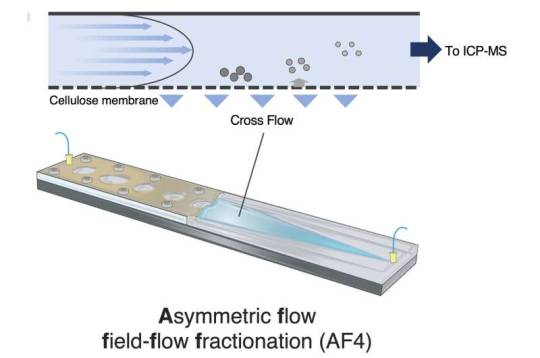
Investigating cell killers: An advanced system for size-dependent cytotoxicity analysis of silica
Metal nanomaterials have become an indispensable part of industrial and medical fields due to their unique and versatile properties. Their size, which imparts them with the desired physiochemical properties, is also the reason for environmental and health concerns. The nano-sized particles in nanomaterials have shown high reactivity towards biomolecules and often even toxicity towards biological cells.
Scientists have attributed this behavior of metal nanoparticles in interaction with biomolecules to phenomena like inflammation or oxidative stress. However, to ensure the safe usage of metal nanoparticles, there is a need to explore molecular mechanisms responsible for the toxicity and understand how the uptake of nanoparticles by cells varies based on their shape, size, morphology, and other aspects.
Read more.
17 notes
·
View notes
Text
Occupational exposure to inhaled crystalline silica dust (cSiO2) is linked to systemic lupus erythematosus, rheumatoid arthritis, systemic sclerosis, and anti-neutrophil cytoplasmic autoantibody vasculitis.
Taken together, diverse disease-relevant autoreactive B cells, including cells specific for DNA, MPO, and basement membrane, are recruited to lung ectopic lymphoid aggregates in response to cSiO2 instillation. B cells that escape tolerance can contribute to local autoantibody production. Our demonstration of significantly enhanced autoantibody induction by TLR ligands further suggests that a coordinated environmental co-exposure can magnify autoimmune vulnerability.
0 notes
Text
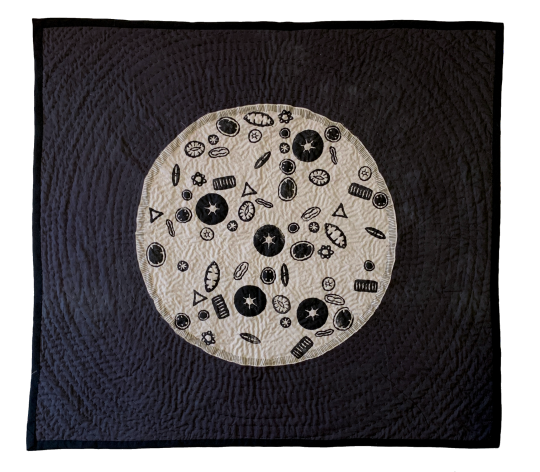

my finished quilt for my undergraduate thesis show! my art practice lately has been spending time with small things the average person doesn’t notice or know about. this quilt is entirely hand printed and hand stitched. show label below:
Little Glass Houses, 2023
Hand-dyed and unbleached muslin, cotton batting, mercerized cotton thread and block printing ink
Diatoms are a prolific single-celled microorganism, found in water and soil across the planet. This quilt "magnifies" them for the human eye in a composition that mirrors the view of a slide under the microscope. The cell walls of diatoms are likened to glass, as they are made up of a thin layer of transparent silica. Replaced by soft cotton and thread, this quilt gives them a dimensional quality that is lost under a microscope.
3K notes
·
View notes
Photo
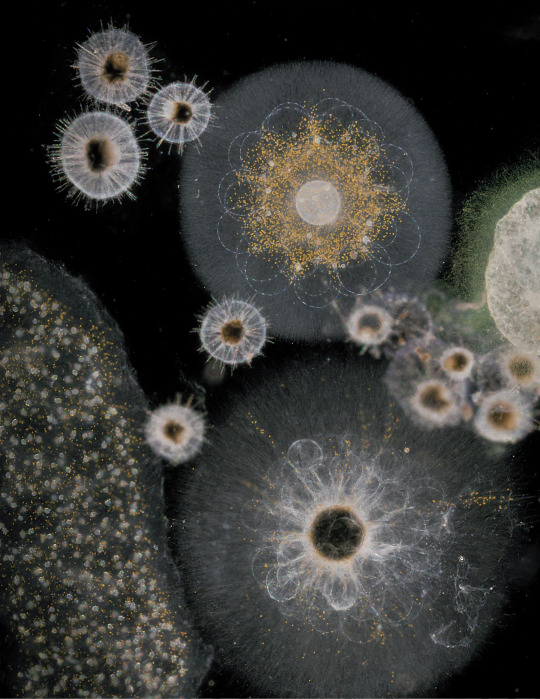
Wonders of the drifting world...
Radiolarians (Polycystinea) are microplanktonic Protozoa characterized by a delicate skeleton of opaline silica, visible here as tiny ocre-colored dots. On the top left is a colonial radiolarian – Christian Sardet, 'Plankton – Wonders of the Drifting World', Univ. Chicago Press 2015
“Take a Breath and Thank Plankton. One out of every five breaths taken by any (and every) life form on the planet comes from a diatom. Diatoms are a kind of phytoplankton: that is, microscopic plants drifting in all bodies of water. They carry out photosynthetic processes, ultimately producing oxygen in the air we breathe.
Like diatoms, single-celled algae that also form silica skeletons, radiolarians sink after death, trapping atmospheric carbon in the sediment of the deep oceans. The composition and distribution of their fossils are used to estimate past water temperature and salinity in the oceans.”
Unraveling the Mysteries of Radiolarians | AMNH…
2K notes
·
View notes
Text
Phylum #2: Porifera, the sponges!
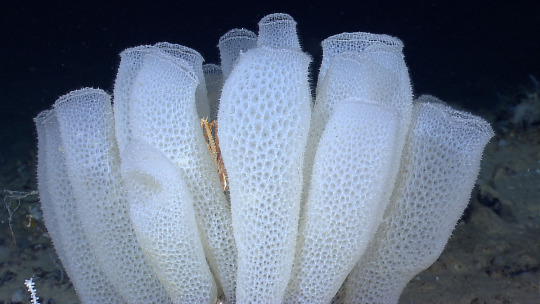

While not the most basal animals, sponges are probably the closest to what the first animals looked like. The basic shape is pretty simple: a surface covered in numerous pores takes in water, funneling it out through a large chimney.
The cells in charge of driving water through the pores, choanocytes, are surprisingly close in function to our closest unicellular relatives, choanoflagellates, hinting at a deep evolutionary connection between us and them. It is believed that the first sponge-like animals arose through multiple choanoflagellate-like cells sticking together, beating their flagella in tandem to filter water together!
While the basic sponge body plan is pretty simple, they have evolved numerous variations on it. Glass sponges have become delicate creatures built upon a silica skeleton, and have been reported to live for up to tens of millenia at the bottom of the ocean!
Meanwhile, deep-water carnivorous sponges capture small prey like crustaceans, with velcro-like hooks and enigmatic balloon-like structures!
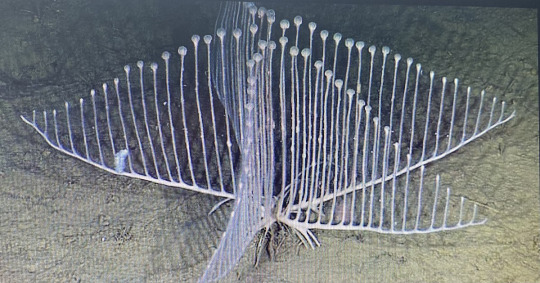

339 notes
·
View notes
Photo
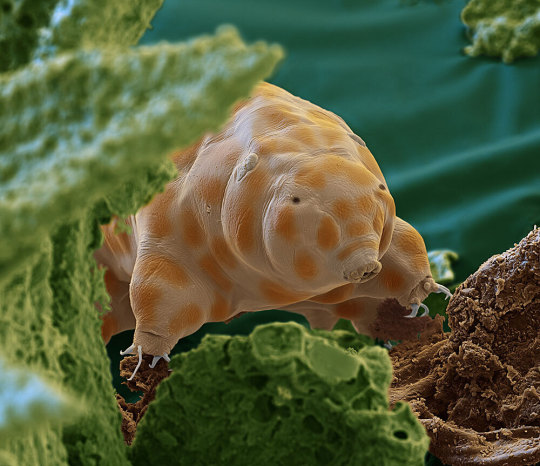
The newfound species seen here is one of about 1,300 known types of tardigrades. It was discovered in moss growing on dead tree trunks in Germany’s Black Forest. Far too small to see with the unaided eye, this creature is among billions of life-forms on the forest floor that are essential to the health of the planet. Magnified 2,400 times.
THESE TINY CREATURES ARE MARVELOUS
PHOTOGRAPH BY OLIVER MECKES AND NICOLE OTTOWA
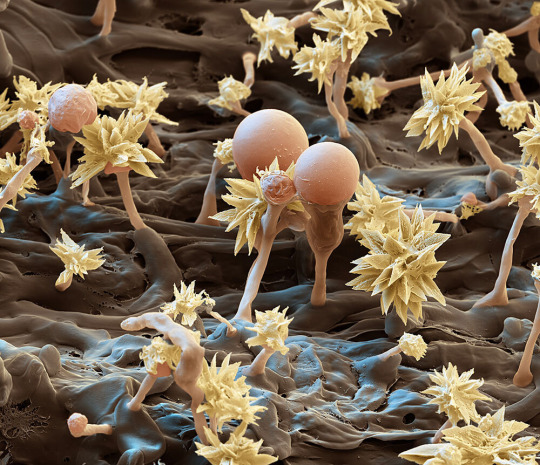
Fungi like this Resinicium bicolor—shown magnified 7,000 times—start breaking down dead trees by digesting lignin, the complex compound that helps form woody cell walls in plants.
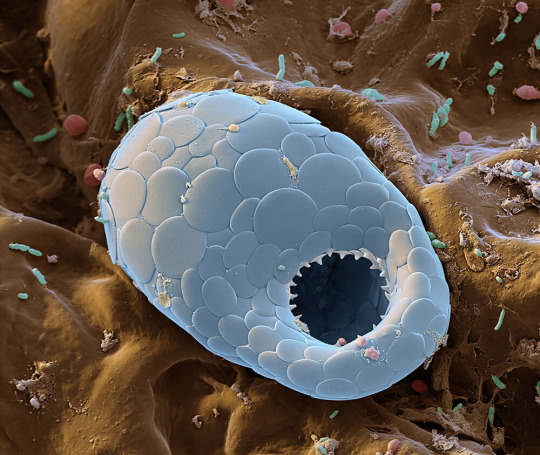
Scales of silica cover the single-celled body of a testate amoeba. These types of amoebas are named for the hard shells they create, possibly for protection against environmental changes within the forest litter.

Resembling a fairy’s gift basket, the fruiting body of a slime mold, magnified 400 times, releases spores from its perch on woody debris draped in fungal filaments. Slime molds feast on other microbes found in decaying plant

Some mycorrhizal fungi make their homes inside plant cells, as seen in this cross section of a European blueberry root. This allows soil residents of very different sizes to exchange nutrients—helping the forest
#oliver meckes#nicole ottowa#photographer#tardigrades#moss#germany#black forest#micro photography#nature#national geographic#fungi#resinicium bicolor#testate amoeba#slime mold#mycorrhizal fungi
634 notes
·
View notes
Text

Our guide rests in the shade of the Vherr-osh, the great sunspires. These glittering towers are composed of thousands of tiny chambers like the units of a compound eye, the inside of each lined with a photosynthetic “retina” protected from the extremes of the subarctic winters and summers.
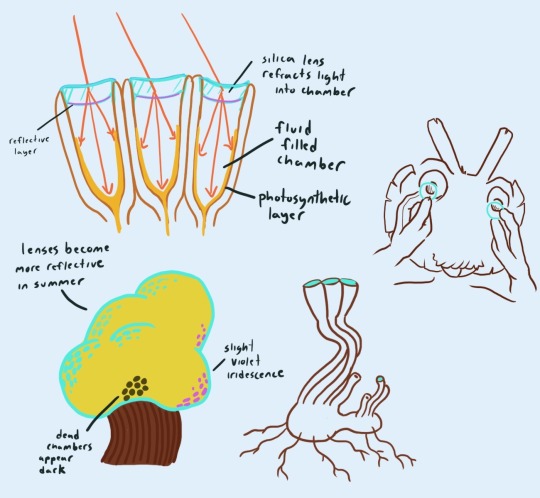
The units are capped by a convex silica lens that refracts light into the chamber to maximize surface area for photosynthesis, while protecting the delicate living cells inside. The reflective lining beneath the lens thickens at the height of summer to prevent overexposure, and is also responsible creates a striking violet iridescence. The lenses are likely derived from silica spicules in the ancestral species; extant relatives still bear these spicules for anti-predation and structure.
These strange trees grow slowly, taking centuries to reach even 5 feet in height. Accounts from the nomads of the region suggest they can live for thousands of years beyond that. A Tuin clan legend attests that they first grew from the shed scales of a primordial bird as it circled the newly formed world. Mature forests such as this were already vanishingly rare by the time I was lucky enough to lay eyes on one. The inhospitable region where they grow is seldom visited by birgs, though just a few centuries before, these lenses were scraped away by the hundreds of thousands to make all manner of decorative windows, sun catchers, even primitive spectacles and telescopes. To this day, some Twowi nobility covet the iridescent crystals as an exotic and expensive jewelry.
723 notes
·
View notes
Text
Fossilised Microbes

When it's Wednesday morning and you've got lots to do, but you are just a blob of tiny vesicles trapped in chert.
Thin section of a Mesoproterozoic organic rich chert (about 1.5 billion years old). Light areas are organic poor, dark areas are organic rich.
The light blob in the middle that looks like frogspawn is a lump of fossilised microbial cells preserved as silica, carbon, and phosphate.
13 notes
·
View notes
Text
I really love organisms with unique types of hard tissue. Trilobites (probably) had mineralized lenses in their eyes made of calcite crystals. The lenses were literally part of the exoskeleton. The scaly-foot snail is the only known animal to use iron sulfide as part of its shell. The armored fish of the Devonian period had armor plates made of bone protecting their head (most depictions show the armor as an exoskeleton, although IIRC there is no actual evidence it was external). Diatoms are a type of algae whose cell walls are made of transparent silica—literally glass.
They're just so cool!
#organismsposting#not sure if hard tissue is actually the correct term of invertebrate exoskeletons but like
170 notes
·
View notes
Text

Chapter 27: What I Lost
As we returned to the base, Albert sat me down. Arjuna and Nighthawk raced up to greet me and Wesker.
"My lady, are you alright? Thank you for keeping an eye on her lord Wesker." Arjuna said, bowing gently.
"Yeah, boss, you gave us quite the scare there. I was quite worried we were going to have to shatter you out with a chisel." Nighthawk said candidly.
"One, you should never chisel me out when I'm in that state. At that point, I'm a dangerous B.O.W. Second, you should have made sure our V.I.Ps were secure, which I saw you do. Now, where is Ms. Gionne?" I asked.
"She is upstairs in her room, my lady. I shall fetch her later, for now, we have Dr. Cordell and his wife tied up how you ordered." Arjuna said.
"Good, now lock down the containment unit and only let me and Albert in the room, and Excella, you, and Nighthawk can watch Arjuna," I said, sighing in a relatively uncomfortable way.
It has been a very long time since I had tortured someone. Not since Sergei commanded me to torture some random traitor who leaked the location of the Russian facility to the local authorities. Now that I think about it, that is probably how Chris and Jill probably found the place. Same as Albert.
I froze the memory of the blazing pain that pierced my chest. Albert noticed my grimace and placed his hand on my shoulder. I turned my head to see his signature. I quickly jerk away. His smirk dropped and a look of concern grew on his face.
"Tabitha are you alright my love." He asked grasping my chin and pulling me towards him.
"No, I'm not. Let's go to the decontamination chamber. I'll show you there." I pulled away again a little more forcefully.
We walked through the base to the containment chamber. I was saluted as I walked past my many agents. Albert followed close behind me. When we arrived at the decontamination shower, I dismissed Archer and Nighthawk and locked down the decontamination showers.
"I know we have not been back together very long dearheart, but I've felt the same about you since our wedding day. You are the only person in the world who I could love wholeheartedly." Albert said pulling me into his arms.
"I know. It is just Vladimir still has his claws sunk in my heart. For years upon years, I heard how much you must have despised me. The years of constant rape, experimentation, and manipulation led me down a dark path." I said moving away and turning on the shower.
"I know Tabitha. I was in the same boat, William called me and told me you had died. That it was Sergei. I should have found you sooner." He said unbuttoning his shirt.
"I have something to show you, my love. One of the abilities of the angelis virus-infected is cell manipulation. I use it to hide things about my body. Call it vain or whatever but I can't stand the sight of these." I said stripping my clothes off and black shards of silica fell off revealing extensive scarring from the U.B.C.S. tattoo removal to where Vladimir carved his name into my flesh. The hideous burns along my legs and a massive gash along my right eye. The most prominent one was five puncture wound scars near my heart.
Albert snarled at the sight and pulled me back into his arms falling back into the shower. His sunglasses were on the floor smashed as if they had been stomped on. My head laid close to his heart and it was racing. I felt Albert's chest rise and fall rapidly.
"Albert, are you alright?" I asked quickly rolling to face him.
His eyes were full of tears and glowing ruby red. he placed his hand on the scars above my heart, "These were caused by when I shot you. I'm pissed with that damn bastard for all this, but I can't forgive myself for what I did to you."
I quickly kissed him. I poured my love into the kiss using my strength to lift the both of us into a sitting position me straddling his hips my chest pressed into his. The warm water caresses our bodies gently as I release the kiss meeting his gaze with my own.
"We have a lot we will have to work through but give it enough time my love and we will be the unstoppable force we were before, so no need for those contractions, my godly king," I said wiping the last of the tears from his eyes.
"What I Lost was nothing compared to what you went through, my dearest lotus flower," Albert said his blazing red eyes meeting my chilling blue.
"What matters now is we rebuild our relationship my beloved Albert Wesker," I said stroking a few wet pieces of hair out of his eyes.
"You are right my treasured Tabitha Wesker," Albert said pulling my head back into his chest.
I blushed feeling his thick member through his silken boxers. I tried to push him away but he held me close and smirked. His cock slowly hardened.
"Albert here?" I asked shyly.
"Why not dear heart I know you locked the doors and it's not like there are any windows in here." He said biting down on my neck his teeth sinking into the junction between my neck and shoulder.
I gasped as he quickly shoved two fingers into my mouth.
"Shhh, my sweet lotus you would not want your agents to hear now would you, my love," He said with a dark chuckle leaving his throat.
He released his bite and blood trickled down my shoulder. A light smell of blood permeated the air. I didn't know how bad the bite was I just knew Albert was quickly lapping up the blood. His sadistic side was showing. When the wound sealed up Albert pulled his fingers from my mouth.
"My lotus I am going to ravage your pretty little body. I want to make you beg for release dear lotus. I will make you cum all over my face." He said laying me on the floor of the massive shower. he lifted my legs onto his well-defined shoulders and lowered his head down into my folds.
With a simple quick movement, Albert's tongue was on my clit flicking it side to side, "I will show you how much you mean to me dearheart."
He shoved his two fingers that were in my mouth deep into my pussy. He lowered his head back down resuming his original actions. Panting, I gripped his hair and lightly pulled at it. His tongue rapidly licked my clit making my vision hazy.
His fingers danced about inside my tightening snatch, curling up and grazing that spongy textured spot. I stared up gazing upon my godly husband's smirk as he added his third and fourth fingers.
I bit my lip, suppressing the moan that was starting to build in my throat. I was in bliss I didn't even notice Albert's other hand reach up for my perky nipples. With a swift motion, he pinched and rolled my left nipple between his fingers. I gasped at the pain as it drove me closer to the edge. My tongue started to hang out as I moaned out losing control of my vocal cords.
"That's my lotus. So adorable making lewd sounds and faces. Such a beautiful slut and it is all for me. Now cum for me slut, let me taste your lovely juices, pet."
His usage of my old bdsm name drove me over the edge. He made me feel amazing and like Sergei's touch was never there. The coil in my lower stomach snapped and I came all over his fingers and face.
"Good pet," Albert smirked pulling out his fingers and licking them clean. He lifted me into his arms and cradled me in the hot water of the shower.
"You know, this reminds me of the time Anette almost caught us at the neighborhood pool shower." I chuckled lightly.
"Well, now we have a new memory we can share, my precious lotus," Albert said setting me down and pumping shampoo from the wall dispenser," now close your eyes, relax, and let me wash your hair."
I laughed and smiled kindly pumping soap into my hands."Then let me wash the cum off your face."
Yay, some soft fluff some sensual moments and some easy dirty fun. Next chapter we will be dealing with decently dark content and gore just for a heads up. I hope ya'll have a great day and continue to enjoy Resident Evil: Arch Angel. My name is Silfarianhawk and I'm not so far away
#albert wesker#resident evil#wesker#wesker x reader#wesker x oc#albert wesker x reader#albert wesker x oc#re wesker#resident evil smut#albert wesker x you#smut#fluff#soft wesker
22 notes
·
View notes
Text
Reproduction among these organisms is asexual by binary fission, during which the diatom divides into two parts, producing two "new" diatoms with identical genes. Each new organism receives one of the two frustules – one larger, the other smaller – possessed by the parent, which is now called the epitheca; and is used to construct a second, smaller frustule, the hypotheca. The diatom that received the larger frustule becomes the same size as its parent, but the diatom that received the smaller frustule remains smaller than its parent. This causes the average cell size of this diatom population to decrease.[15] It has been observed, however, that certain taxa have the ability to divide without causing a reduction in cell size.[58] Nonetheless, in order to restore the cell size of a diatom population for those that do endure size reduction, sexual reproduction and auxospore formation must occur.[15]
Vegetative cells of diatoms are diploid (2N) and so meiosis can take place, producing male and female gametes which then fuse to form the zygote. The zygote sheds its silica theca and grows into a large sphere covered by an organic membrane, the auxospore. A new diatom cell of maximum size, the initial cell, forms within the auxospore thus beginning a new generation.
14 notes
·
View notes
Text
When an electric vehicle is parked outside, its temperature can swing wildly from day to night and season to season, which can lead to deterioration of the battery. To dampen these fluctuations and extend the battery's lifespan, researchers have designed an all-season thermal cloak that can cool an electric vehicle by 8°C on a hot day and warm it by 6.8°C at night. The cloak, made predominantly of silica and aluminum, can do so passively without outside energy input and operates without any modification between hot or cold weather. This prototype is described July 11 in the newly launched Device, an application-oriented sister journal to Matter, Joule, and Cell.
"The thermal cloak is like clothes for vehicles, buildings, spacecrafts, or even extraterrestrial habitats to keep cool in summer and warm in winter," says senior author Kehang Cui, a materials scientist at Shanghai Jiao Tong University.
To dampen natural temperature fluctuations, the cloak isolates the car -- or any other object beneath it -- from the surrounding environment. The cloak has two components: an outer layer which efficiently reflects sunlight and an inner layer that traps heat inside. Whatever heat the outer layer does absorb is emitted in such a way that it can be readily dissipated to outer space. This design earns it the name of Janus thermal cloak, inspired by the two-faced Roman god Janus.
Read more.
17 notes
·
View notes
Note
Bunch of answers:
-The thing in the picture is a 𝘚𝘺𝘳𝘪𝘯𝘨𝘢𝘮𝘮𝘪𝘯𝘢 𝘧𝘳𝘢𝘨𝘪𝘭𝘪𝘴𝘴𝘪𝘮𝘢, a kind of Xenophyophorean, which are specialized foraminiferans known for making funky tests (shells) out of sediments. It has no relationship to plants and can't photsynthesize, not sure where you gor that from :)
-SARS viruses have no relationship to the SAR clade. SARS stands for Severe Acute Respiratory Syndrome whereas (T)SAR is just the initials of its majour groups. The name similarity is a complete coincidence.
-S: Stramenopiles is a diverse group of organisms also called Heterokonts (greek for different flagella), as most have at one point of their life cycle 2 flagella, one with and one without "little hairs" on top of the flagellum and the length is also different. Some notable representatives:
• Oomycetes, also known as pseudofungi, which are organisms that look quite a bit like fungi (they form hyphae and micelia) but have no relationship at all. Some are saprophytes whereas others are parasites of plants and fish, including potato blight, the organism that caused the Irish Potato Famine
• Diatoms: Unicellular algae which form very beautifully patterned shells out of silica (so glass), and are very abundant.
• Brown algae: Brown algae have no relationship to plants or other algae. Unlike plants and red and green algae, which acquired their chloroplast from a primary endosymbiosis event with a cyanobacteria, brown algae and many other unicellular algae acquired their chloroplasts by undergoing endosymbiosis with 𝘢𝘯𝘰𝘵𝘩𝘦𝘳 already existing alga. (look into endosymbiosis theory if u have no idea whats going on here)
-A: Alveolata are organisms which have a kind of sacs made of membrane under their main membrane called alveoli. They are also incredibly diverse. They include
• Dinoflagellates: A kind of algae which (in some cases) modified their alveoli to fill them up with cellulose and form a kind of shell. They have funky shapes and are often abundant in the sea. Some of them are known for causing massive blooms which turn the sea red (red tides) and can cause food poisoning if you eat seafood from where a bloom happened.
• Ciliates: Organisms known for having lots of cilia on their bodies, won't go into them because they're very diverse and different, but you can think of a 𝘗𝘢𝘳𝘢𝘮𝘦𝘤𝘪𝘶𝘮 for a typical example of a ciliate.
• Apicomplexans: Mostly parasitic organisms which have a sort of "complex" on the tip of the cell which helps them inject themselves into other cells, this includes the organism which causes malaria, 𝘗𝘭𝘢𝘴𝘮𝘰𝘥𝘪𝘶𝘮.
-R: Rhizaria are amoeboid organisms which often have long pseudopodia called filopodia and are, who would've guessed, also very diverse. The most well known of them are
•Formanifera: A group of mostly marine organisms which form single or multi-chambered shells which can get very complex and are abundant in the sea, so much so that if you know which foraminifera lived in which time periods, you can use their shells in marine sediments to assign a date to them.
• Radiolarians: Organisms which are known for making very intricate and beautiful shells which are very diverse in shape. Look up some of Ernst Haeckel's illustrations of Radiolarians.
-T: Regarding the Telonemia, very few species are described and they aren't very well known, but genetic analysis placed them close to the SAR clade so the acronym is sometimes extended to TSAR
Hope all this helps
THANK YOU SO MUCH MY DUDE THIS IS AN AMAZING ANSWER AHAHAHAHA

^this is why I thought they were related to plants, because both SAR and plants / plant-related things are in this clade, and it says most of the organisms which can photosynthesise are in this clade. But I misunderstood it, thinking it meant most of the organisms that are in this clade can photosynthesise. So, SAR can’t photosynthesise. Is this article wrong to say SAR and plants are related?
Ok so I found this article, which has this tree of life in it-

Which suggests plants and TSAR are very loosely related in that they’re closer than eg opisthokonts. And this was in 2020 so is probably fairly close to how things are modernly. (I haven’t fact checked this article. I hope it’s mostly true…)
ANYWAYS
If the xenophyophore makes itself a shell, is that what you can see in the photo? Is the organism itself smaller than the shell or does it fill it? The shell is made of sediment, is it the texture of sediment? All squishy? Or is it shell-ish?
What does saprophyte mean? (Nvm I googled it, it means something which munches upon dead things to survive)
OH DIATOMS SOUND SO COOL!! Kinda like glass sponges but tiny algae!!
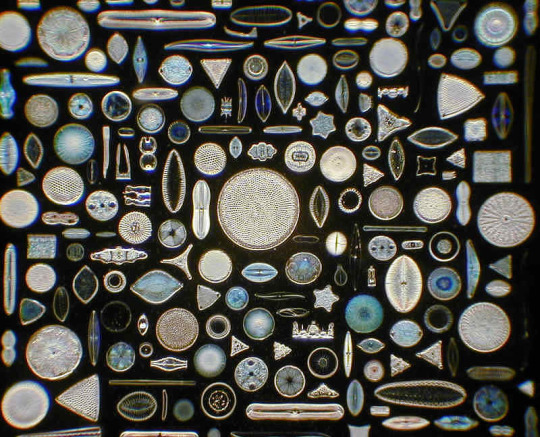
oh wowwww they’re stunning! gorgeous! i love them! beautiful! new favourite organism!
i am thrilled by the fact that plants get their chloroplasts from cyanobacteria. I did not know that. Everything relies on cyanobacteria?!?! Where do cyanobacteria get their chloroplasts from btw?
do the alveoli contain the rest of the cell or are they just empty? what’s in the alveoli? Does that just depend on what specific alveolate it is or do most alveoli have a similar function?
14 notes
·
View notes
Text
How to Grow Your Nail Fast
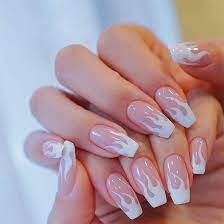
Introduction
Understanding Nail Growth
Nail growth might seem like a simple biological process, but it's influenced by various factors. Learning how to support and accelerate nail growth requires understanding the fundamentals of nail health and the mechanisms behind their growth.
Proper Nail Care
Maintain Hydration
Proper hydration isn't just beneficial for your skin; it's crucial for nail health too. Dehydrated nails are prone to brittleness and breakage, hindering growth. Ensure you're drinking enough water throughout the day to keep your nails hydrated from within.
Balanced Diet
Nails, like any other part of your body, require essential nutrients to grow strong and healthy. Incorporate a balanced diet rich in vitamins, minerals, and proteins. Foods like leafy greens, eggs, nuts, and fish can provide the necessary nutrients for optimal nail growth.

Avoid Harsh Chemicals
Exposure to harsh chemicals, such as those found in detergents and cleaning agents, can weaken nails and slow down growth. Wear gloves when handling such substances to protect your nails from damage.
Protective Measures
Keep Nails Trimmed
Contrary to popular belief, keeping your nails trimmed actually promotes faster growth. Regular trimming prevents split ends and breakage, allowing your nails to grow longer without the risk of damage.
Wear Gloves
Whether you're doing household chores or working outdoors, wearing gloves can shield your nails from potential harm. They act as a barrier against chemicals, harsh weather conditions, and physical trauma, safeguarding your nails and promoting healthy growth.
Nutritional Supplements
Biotin
Biotin, also known as vitamin B7, is renowned for its role in promoting healthy hair and nails. Consider taking biotin supplements or incorporating biotin-rich foods like eggs, almonds, and avocados into your diet to support nail growth.

Vitamin E
Vitamin E is an antioxidant that aids in repairing damaged cells, including those in your nails. It promotes circulation to the nail bed, which can stimulate growth. You can find vitamin E in foods like spinach, broccoli, and almonds or opt for supplements.
Moisturizing Treatments
Jojoba Oil
Jojoba oil is a natural moisturizer that can penetrate deep into the nail bed, nourishing and strengthening the nails from within. Massage a few drops of jojoba oil onto your nails and cuticles daily to keep them hydrated and promote faster growth.
Shea Butter
Shea butter is rich in vitamins A and E, as well as fatty acids, making it an excellent moisturizer for nails and cuticles. Apply shea butter directly to your nails before bedtime and let it absorb overnight for maximum hydration and growth benefits.
Avoiding Nail Damage
Limiting Exposure to Water
Excessive exposure to water, especially hot water, can weaken nails and make them more prone to breakage. Wear gloves while washing dishes or cleaning, and try to minimize the time your nails spend submerged in water to maintain their strength and integrity.

Gentle Nail Care Practices
Avoid using your nails as tools for tasks like opening cans or scraping off stickers, as this can cause damage and hinder growth. Instead, use proper tools and techniques to protect your nails from unnecessary stress and trauma.
you can also try this product ProNail Complex
Massage Techniques
Stimulating Blood Flow
Massaging your nails and cuticles can improve blood circulation to the nail bed, delivering essential nutrients and oxygen for faster growth. Use gentle, circular motions to massage a nourishing oil or cream into your nails daily for optimal results.
Promoting Nail Growth
In addition to enhancing blood flow, nail massage can also stimulate the production of keratin, the protein responsible for nail growth. Incorporate massage into your daily nail care routine to encourage stronger, longer nails.
Herbal Remedies
Horsetail Extract
Horsetail extract is rich in silica, a mineral essential for collagen formation and nail strength. Taking horsetail supplements or using products containing horsetail extract can fortify your nails and promote faster growth.
Aloe Vera Gel
Aloe vera gel is well-known for its soothing and healing properties, making it ideal for treating brittle nails and stimulating growth. Apply fresh aloe vera gel to your nails and cuticles regularly to nourish and strengthen them from the inside out.
Patience and Consistency
Setting Realistic Expectations
While implementing these tips can accelerate nail growth, it's important to remember that nails grow slowly, typically around 1-3 millimeters per month. Be patient and consistent with your nail care routine, and you'll gradually see improvements in the health and length of your nails.
you can also try this product ProNail Complex
Establishing a Routine
Consistency is key when it comes to promoting nail growth. Establish a daily or weekly nail care routine that includes moisturizing, trimming, and protective measures to ensure optimal nail health and growth over time.

Professional Help
Consulting a Dermatologist
If you're experiencing persistent nail problems or slow growth despite following a healthy nail care routine, consider consulting a dermatologist. They can identify underlying issues and recommend specialized treatments or medications to address your specific concerns.
Nail Strengthening Treatments
In some cases, professional nail strengthening treatments may be necessary to promote faster growth and improve the overall health of your nails. These treatments often involve specialized formulas or procedures designed to fortify and protect the nails from damage.
Conclusion
Summary of Tips
Growing your nails faster requires a combination of proper nail care, nutritional support, protective measures, and patience. By maintaining hydration, avoiding damage, incorporating nourishing treatments, and seeking professional guidance when needed, you can achieve stronger, longer nails and flaunt your manicures with confidence. Remember to be consistent and patient in your nail care routine, and you'll soon enjoy the benefits of healthier, more beautiful nails.
you can also try this product ProNail Complex
DISCLAMER
There are ab affiliate link of a products in this articlewhich may make some profit to me.
6 notes
·
View notes
Text
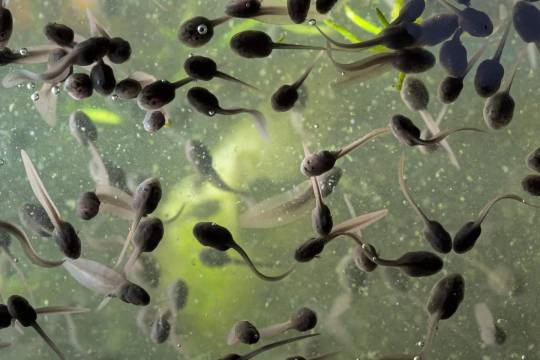
Ephemeral Pool
BY TINA MOZELLE BRAZIEL
means it won’t always be
here. Means puddle said
in a highfalutin way. Means
the sun and soil will Shop-Vac
this water like these dirt daubers
and bees, like the coyote
and turkey who tracked
through the middle
to drink it up.
Biodiverse is another way
of saying rain pooled
on a dirt road atop a ridge
in Alabama. It’s a nod
of respect to tadpoles
shimmying and turning
their opal bellies up
to catch the light
and the mosquito larvae
flicking tail against head
to dive and surface.
It means that in a single drop
there’s a galaxy
of single-celled creatures
thriving inside
delicate silica walls
just as they did
when dinosaurs splashed
through puddles.
Their bodies are glass houses
is what some say.
Maybe we should all say,
when we look to diatoms
and ask how to love our neighbors
enough to keep
from throwing any stones.
https://www.poetryfoundation.org/poetrymagazine/poems/155910/ephemeral-pool
,
14 notes
·
View notes